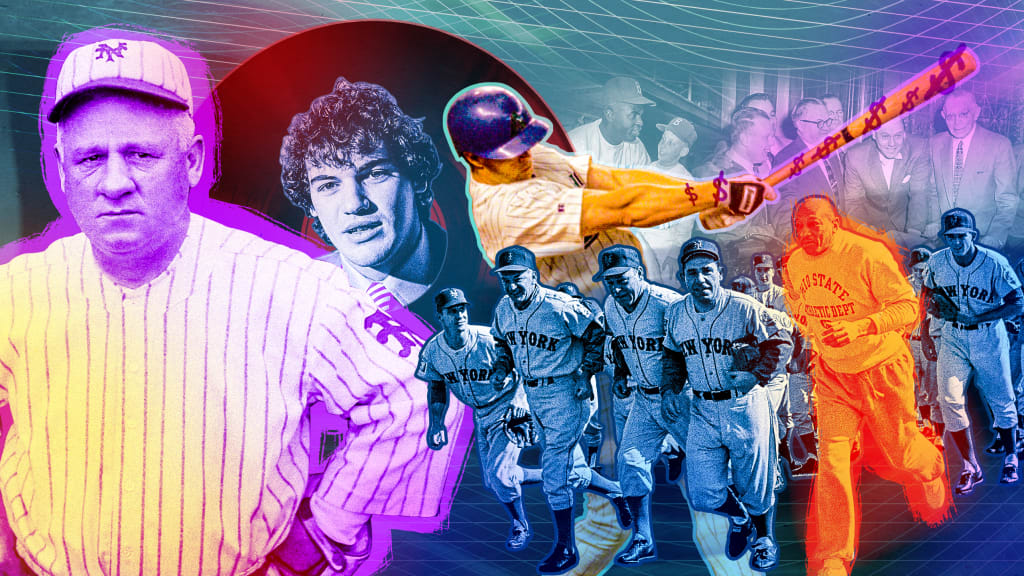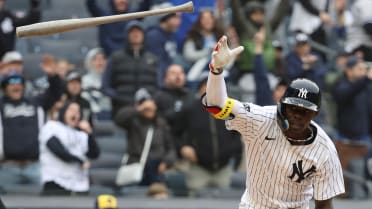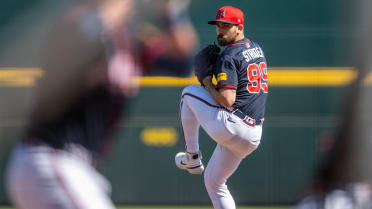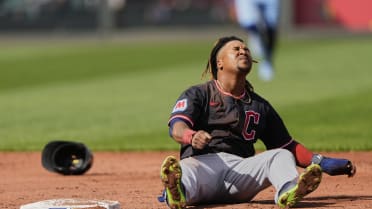
A version of this story was originally published in May 2020.
With well over 100 years of history, even the most die-hard, obsessive, has-a-shrine-to-the-game-hidden-in-the-closet type baseball fan can’t know everything. So, here, below, is one interesting fact about each team that you may not know.
And if you have a favorite that I missed, let me know.
Angels

Forget the giant halo’d "A" that sits in the parking lot outside Angel Stadium -- every person who has attended an Angels game knows the real landmarks are the giant caps perched right outside the gates.
What you may not know is that the caps have an official New Era size. Forget your standard 7 3/8, these monstrosities are measured at 649 1/2.
Astros
I’m not sure what’s stranger: That there was a rainout at the Astrodome, or that during it the players all ate their dinner on the field.
Here’s the story: On June 15, 1976, heavy rains and intense flooding throughout the Houston area necessitated the postponement of that evening's game between the Pirates and the Astros, as fans and workers would be unable to enter the building. However, because ballplayers report so early, they were already at the stadium.
With the game postponed, the staff set up a meal around second base for the players -- with about 20 fans that had managed to make it through the turnstiles treated as guests of honor.
As for what was on the menu, pitcher Paul Siebert doesn't remember. Probably because there were "more drinks than food," he said.
A's
Owner Charlie Finley is credited with some of the greatest -- and weirdest -- ballpark promotions in history. But the strangest one has to be Harvey the Rabbit. The cartoonish creation would rise out of the ground to deliver baseballs to the umpire.
After being phased out in 1971, there are rumors that the original Harvey was buried beyond the outfield wall in the Coliseum.
If this sounds familiar to you, well, it should: The team brought back a remote-controlled version of the rabbit in 2018.
Blue Jays
You may think that the official Blue Jays anthem is "OK Blue Jays" -- a song the team plays during the seventh-inning stretch. But there's actually a different song that was commissioned by the team for its first season in 1977.
That's this disco-inspired track credited to "Paul's People." It's a bit of a misnomer, as the song was written by Dr. Michael Lococo Sr. -- now a dentist in Niagara Falls, Ont. -- and was recorded with studio musicians.
For his part, Lococo told MLB.com that he was given tickets and a sweet Blue Jays warm-up jacket.
Braves
Plenty of Braves players are in the record books, but Red Barrett has perhaps the strangest reason. On Aug. 10, 1944, Barrett pitched a shutout against the Reds, winning 2-0. The most notable part: Barrett needed a record-low 58 pitches to complete the most efficient game in history.
The game also set a record for shortest nine-inning night game; it took only one hour and 15 minutes to complete.
Brewers
There's only one ballpark where you can top your hot dog in "Secret Stadium Sauce." It's all thanks to a little ingenuity.
During a game in the 1970s, the stadium was running low on condiments. So, vendor Rick Abramson -- now an executive with Delaware North -- mixed barbecue sauce, ketchup, mustard and a few other odds and ends to create the topping. Now, almost 50 years later, it's a regional favorite that you can even buy in the grocery store.
Cardinals
The Cardinals may have birds across their chest and a giant bird as their mascot, but that's not actually the source of their name. Like so many teams in early baseball history, they got their moniker from their socks. Originally known as the "Perfectos," columnist Willie McHale overheard a young woman refer to the team's hosiery as a "lovely shade of cardinal." And from there, the name was born.
Cubs
Back on Sept. 14, 2008, Cubs right-hander Carlos Zambrano tossed a no-hitter against the Astros. It was the Cubs' first no-no since Milt Pappas held the Padres hitless in 1972.
With that gem against Houston, Zambrano -- whose nickname was Big Z -- became the first pitcher with a last name that starts with Z to throw a no-no (Jordan Zimmermann made it two with his no-no for the Nats in '14).
But the weirdest part of this game was its location. Due to Hurricane Ike, the series had to be relocated, with the Astros serving as the "home team" at Miller Park. As a result, Zambrano's no-no was the first neutral-site no-hitter, per the Elias Sports Bureau.
D-backs
If you've ever watched a game, you've likely seen those promotions where one lucky fan can win a prize if the team pulls off a particular feat. Rarely are those worth $1 million. Thanks to Jay Bell, one lucky fan hit the jackpot.
Facing the Oakland A's on July 11, 1999, Gylene Hoyle was asked to pick a player and inning she thought a D-back would hit a home run. If she got it right, she would win the prize. So, Hoyle picked Jay Bell, one of the team's best hitters that year, and chose the sixth inning.
After the D-backs loaded the bases, Bell came to the plate. After working the count full and fouling off some pitches, he hit the million-dollar dinger.
Dodgers
If things were a little different, perhaps the Dodgers never would have moved to Los Angeles, but instead would be known as the Jersey City Dodgers. While the team was in discussions with New York City and considering a move, it played 15 games at Roosevelt Stadium in Jersey City from 1956-57.
Though it didn't work out long-term, the team seemed to enjoy playing there: The Dodgers went 11-4 in games played at the stadium.
Giants
The Giants have been noted for their classic black-and-orange look throughout their history -- whether in New York or San Francisco. But for four seasons starting in 1913, they rocked violet. Why? Because John McGraw liked NYU's colors. The team even kept the color for one of the strangest uniforms in the sport's history when they wore a very business casual-friendly checkerboard pattern.
Guardians
One of the strangest players in history also has his very own theme song. Joe Charboneau -- who fixed a broken nose with pliers, cut out a tattoo with a razor, and would have people break rocks against his chest -- became a star with Cleveland en route to winning the Rookie of the Year Award in 1980. That was enough to inspire the song "Go Joe Charboneau," which reached No. 3 on the local charts.
You can listen to it here.
Mariners
Two big league teams have called Seattle home: The Seattle Pilots, who moved to Milwaukee after their only season in 1969, and the Mariners, who joined the big leagues in 1977. Only one player can claim to be an alumnus of both: pitcher Diego Segui.
While he was successful in his first stint in the city -- going 12-6 with a 3.35 ERA -- he wasn't so good the second time around. Segui was 0-7 with a 5.69 ERA with the '77 Mariners.
Marlins
The Marlins are (probably) the only team whose mascot lost its head during a parachuting accident. On Opening Day 1997, a Navy SEAL dressed as Billy the Marlin parachuted into the ballpark. Unfortunately, an unexpected gust of wind blew the head off the skydiver, who had to land in the park without it.
The head was eventually recovered months later when two fans found it resting on a retaining wall along the Florida Turnpike.
Mets
After finishing second-to-last in the NL in stolen bases with 36 in 1964, the Mets knew what they had to do for the next year: Bring in Olympian Jesse Owens as the team's running coach. After leading the team in a series of sprints -- about two miles in total length -- Owens told the New York Times, "They all run flat-footed when they come here -- it's an occupational thing with baseball players. But now they're up on their toes and they've got some spring when they run."
Unfortunately, the coaching didn't help. The Mets only stole 28 bases in '65 -- and were caught 42 times.
Nationals
How many ballparks do you know that are influenced by art museums? Well, there's at least one. Built by HOK Sport and opened in 2008, Nationals Park features "steel, glass and pre-cast concrete," which are inspired by the National Gallery of Art's famed East Wing that was designed by architect I.M. Pei.
Orioles
One of the coolest parts of Camden Yards is Eutaw Street, which sits beyond the outfield wall and is marked by more than 100 plaques marking every home run that has landed there since the stadium opened.
Unfortunately for O's fans, for many years, the longest didn't belong to an Orioles player. Instead, the title was held by the Expos' Henry Rodriguez, who hit a 443-foot blast on June 17, 1997. (Rodriguez now shares the distinction with Baltimore's Anthony Santander, who tied him on Aug. 24, 2021).
Padres
You'd think it would be easy to watch the last out of the game when Trevor Hoffman is your closer. After all, the Hall of Fame pitcher saved 601 games in his career. But the late Padres GM Kevin Towers didn't see many of them -- because he was too stressed to take in the final outs.
Like Billy Beane, who famously doesn't watch A's games, Towers would sit in the manager's office with the TV off when Hoffman entered. If he heard cheers, then he knew his closer had been successful.
Phillies
In a weird way, you can thank the Phillies for the DH being restricted to the AL. In 1980, the NL came together to vote on whether to introduce the DH to their league. Phillies owner Ruly Carpenter instructed his VP, Bill Giles, to vote for the DH because the team had two young hitters vying for the same spot, and they wanted to get both of their bats into the lineup. Because the results wouldn't take effect until 1982, Giles was unsure what to do. He tried to phone Carpenter, but the owner was on a fishing trip and couldn't be reached.
Not wanting to do the wrong thing, Giles abstained from the vote. That meant Pirates GM Harding Peterson -- who had been instructed to do just as the Phillies did -- also chose not to vote.
That was enough to kill the measure: five teams voted against the DH, four voted for it and three -- including the Phillies and Pirates -- abstained.
Pirates
Were it not for Bing Crosby's superstition, there would be no full-game video for Game 7 of the 1960 World Series -- the game that ended with Bill Mazeroski's Series-winning walk-off home run.
Crosby -- a part-owner of the Bucs -- believed that he was a jinx to the team. So, he flew to Paris with his wife and listened to Game 7 on the radio. But he thought ahead and hired a company to film the game off his television. This recording was found in a wine cellar in 2010, and it is the only complete copy of the game in existence.
Rangers
When people think of Ted Williams' managerial career, they think of him as the skipper of the Washington Senators. But for the Rangers' first season, Williams was the man in the dugout. The Splendid Splinter signed a five-year deal with the Senators in 1969, and he stayed with the team when it made its move to Texas in 1972. But after bottoming out with a 54-100 record in Texas -- the fourth straight year with fewer wins than the season before -- Williams resigned with a year left on his contract.
Rays
Plenty of weirdness happens when a ball hits the catwalk that hangs under The Trop's domed roof. But the first player to test the rules was Edgar Martínez. On May 28, 1998, Martínez launched a ball off the "D" ring for the first ground-rule home run at the stadium. Former Rays third baseman Evan Longoria was the first to do it in the postseason.
Reds
File this under one of the most unbelievable things on this list. The last Reds player to pull off a double steal of home was ... Adam Dunn. The Big Donkey -- known for anything except his speed -- accomplished the feat on a double-steal with Austin Kearns in 2004. Billy Hamilton nearly pulled it off, but the ruling was later changed to a fielder's choice.
Red Sox
Forget the Green Monster -- the weirdest part of Fenway's outfield was actually directly in front of the wall. Similar to Tal's Hill in Houston, there was a 10-foot-high incline in left field that could be used for standing-room crowds ... and it was considered in play.
The incline became known as Duffy's Cliff, named after left fielder Duffy Lewis, who was famed for making running catches up the hill. Duffy's Cliff remained in place until it was razed following the 1933 season.
Rockies
Ever wonder why a team named after the mountains has a purple dinosaur as its mascot? You can thank the construction of Coors Field for that. When Coors Field was under construction, builders came across a four-inch rib and some bone fragments. Unfortunately, no one knows just which type of dinosaur they belong to as dinos are usually identified by their skulls, but they know they belong to a plant-eater.
That was enough to inspire the team to create the Triceratops mascot and even have it hatch out of an egg before the Rockies' first home game.
Royals
George Brett was anything but a .200 hitter, but you can thank him for popularizing the term "Mendoza line." Though it was likely coined the year before by Mario Mendoza's Mariners teammates, Brett made it mainstream.
Struggling with a slump at the start of the 1980 season, Brett told reporters that "the first thing I look for in the Sunday papers is who is below the Mendoza line." Of course, Brett had nothing to worry about. He finished the season with a .390 batting average.
Tigers
If not for an offseason trip to Hawaii, Babe Ruth may very well have become the Tigers manager. After the 1933 season saw Ruth "slump" to 34 home runs with Detroit finishing fifth in the American League, Tigers owner Frank Navin wanted a new skipper. Knowing that Ruth was interested in becoming a player-manager, the owner reached out to Babe. Only problem: Ruth was set to travel to Hawaii for a series of exhibition games and a golf tournament.
After Ruth didn't give Navin an immediate answer -- and stated his desire for a hefty salary and a cut of ticket sales -- Navin moved on to his second choice: Mickey Cochrane -- who became Detroit's player/manager and led the team to the World Series in 1934 and '35, winning it in the second appearance.
Twins
This one may seem obvious once you hear it: You know those two guys shaking hands in the old school Twins logo? They're named Minnie and Paul -- for Minneapolis and St. Paul -- the Twin Cities that make up the Twins' name. Duh.
White Sox
While not every uniform experimentation the White Sox did took off -- hello, baseball shorts -- you can thank them for names on the back of the jersey.
Once again, this was a Bill Veeck invention. While watching the team on TV in 1959, Veeck wondered why fans at home could more easily identify the players, thanks to their names being projected on the screen. So, for the next season, the players had names on the backs of their jerseys. The rest of the sports world soon followed.
Yankees
You could blame the Yankees for the original death of the bullpen car. While the most popular and enduring ones featured giant, goofy baseballs on wheels, the Yankees opted for a pinstriped Toyota Celica and Datsun. That was the beginning of the end for the carts, which no longer seemed whimsical or exciting, but rather looked like things your parents drove.
On the plus side, you could buy yourself one if you wanted.
Michael Clair writes for MLB.com. He spends a lot of time thinking about walk-up music and believes stirrup socks are an integral part of every formal outfit.




